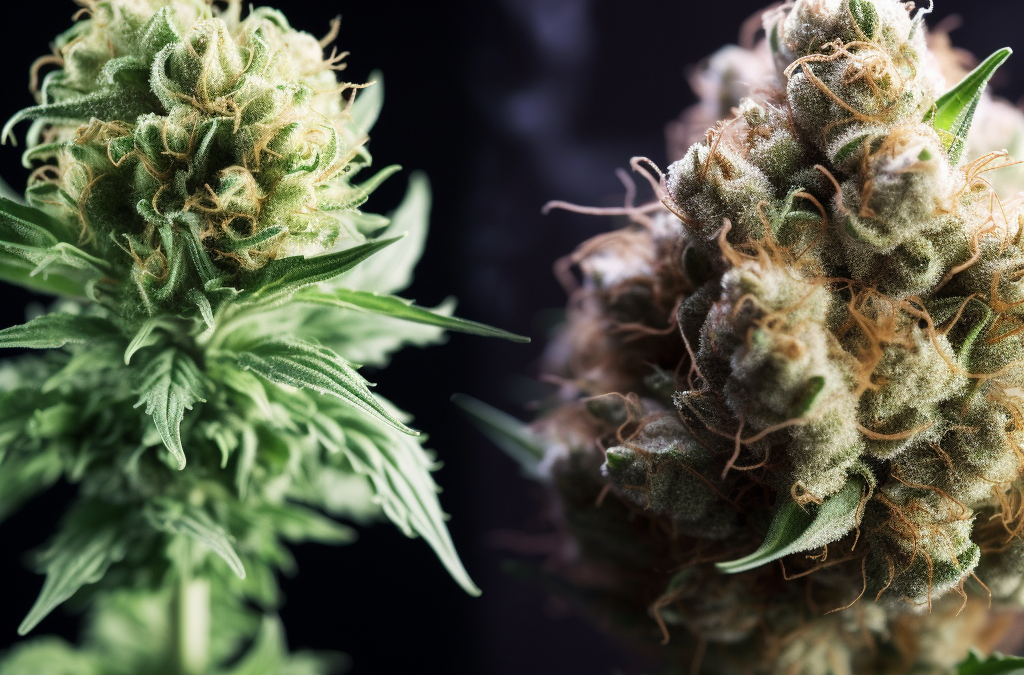
Sativa vs. Indica: What are the differences?
The distinction between Sativa and Indica cannabis strains is familiar to many people. It is believed that Sativa strains have stimulating effects and are ideal for activities, social interactions, and creative projects. On the other hand, Indica strains are said to have relaxing effects and have a stronger impact on the body, making them better suited for relaxation and sleep at the end of the day. While this distinction is deeply rooted in mainstream cannabis culture, there is actually a lack of scientific evidence to support it.
Research shows that there are many other factors that determine the effects of a cannabis strain, and whether it is classified as Sativa or Indica does not play a significant role in that regard. Therefore, the question arises about what the actual differences between Sativa and Indica are and how they truly affect us. To understand this, it is important to start from the basics.
The Origins of Indica and Sativa: A Historical Perspective
Cannabis has been cultivated for thousands of years. Archaeological evidence shows that both the Chinese and the Japanese were utilizing the cannabis plant as early as the pre-Neolithic period.
However, it was during the Renaissance period that a German botanist named Leonardt Fuchs coined the term “Sativa” to describe domesticated hemp.
Later, in the 18th century, the Swedish botanist Carl Linnaeus adopted the Latin name “Cannabis Sativa” for hemp in his book “Species Plantarum.” “Sativa” simply means “cultivated” in Latin and refers to the hemp crops grown in Europe and Western Europe, primarily for their fibers and seeds. Approximately 30 years later, Jean-Baptiste Lamarck described another variety of cannabis, which he believed to be a distinct species called Cannabis Indica. “Cannabis Indica” translates to “from India” in Latin and refers to the wild-growing, psychoactive variety of cannabis discovered in India, which was used for the production of hashish.
Due to centuries of geographical separation, these two cannabis populations developed into two distinct cannabis species through natural and artificial selection, resulting in significant differences between them.
However, among botanists, there is still disagreement regarding whether Cannabis Sativa and Cannabis Indica are truly two separate species or if Cannabis Indica is simply a subspecies or variety of Cannabis Sativa. This is a topic that continues to be controversially discussed to this day.
To further complicate matters, in 1924, a third cannabis species called Cannabis Ruderalis was classified by Russian botanist D.E. Janischewsky. “Ruderalis” essentially means “ruderal” or “weedy,” as ruderal plants are the first to grow in areas cleared of other vegetation. Cannabis Ruderalis is a self-flowering cannabis variety that grows wild in Eastern Europe and was first discovered in Siberia.
The current usage of the terms in relation to cannabis
Today, it is known that the term “Sativa” was originally used for hemp, while “Indica” was associated with psychoactive cannabis strains. That means that most of the cannabis strains available today actually descend from the original Cannabis Indica strain, while the plant originally referred to as “Cannabis Sativa” is primarily used for industrial purposes such as hemp fiber extraction, food products, and also for CBD.
Indeed, these terms have evolved in the modern world, and their meanings have shifted over time. Over time, as cannabis consumption increased and cannabis culture spread worldwide, the terms “Sativa” and “Indica” have evolved into a method of categorizing the thousands of cannabis strains available on the market today.
Sativa Today
- Originally classified as Cannabis Indica ssp. Indica
- Tall and slender, reaching a height of 5 to 18 feet or more
- Long and narrow leaves
- Fewer branches
- Commonly associated effects: Uplifting, stimulating, “mind high,” supports productivity and creativity.
Indica today
- Originally classified as Cannabis Indica ssp. afghanica
- Short and bushy, reaching a height of 2 to 4 feet.
- Broad leaves
- The buds are typically wider.
- More branched
- Commonly associated effects: Relaxing, calming, pain-relieving, sleep-inducing.
Current Research Findings on Sativa and Indica
While the widespread belief that Sativa and Indica have different inherent characteristics and effects persists, there is no scientific evidence to support this claim. Indeed, it is a myth that is often found in popular literature.
Dr. Ethan Russo, MD, an expert on the human endocannabinoid system, explains, “There are biochemically distinct cannabis varieties, but the distinction between Sativa and Indica, as commonly understood in the lay literature, is total nonsense and meaningless.” Currently, the biochemical content of a cannabis plant cannot be predicted based on its height, branching, or leaf morphology. The degree of hybridization has advanced to a point where only a biochemical test can reveal to a potential consumer or scientist what actually resides within the plant.
In short, the only real difference between Sativa and Indica cannabis plants lies in their appearance and growth patterns. Sativas tend to be tall and slender, while Indicas are short and bushy. Additionally, all known cannabis strains today are hybrids, resulting from various combinations of Sativas and Indicas.
If the classification of Sativa and Indica is not suitable for predicting the effects of a specific cannabis strain on you, what factors come into play?
In reality, three factors are responsible for the effects of cannabis strains: the chemical profile, your individual biology and tolerance, and the method of cannabis consumption.
It is important to note that the chemical profile, including the concentrations of cannabinoids like THC and CBD, as well as other compounds such as terpenes, can influence the effects of a strain. Your individual biology and tolerance also play a role as people can have different responses to cannabis. Lastly, the method of consumption, whether it’s smoking, vaporizing, or consuming edibles, can influence the type and intensity of the effects experienced from cannabis.
Therefore, it is advisable to gather individual experiences and try different strains to determine which ones best suit your personal needs and preferences. An open and receptive approach to the diversity of cannabis strains can help you find the one that best suits you.
The Chemical Composition of Cannabis: A Detailed Look at Its Components
Let’s start with the chemical profile. Cannabis consists of hundreds of chemical compounds that can produce a variety of therapeutic and relaxing effects, which can be experienced through the consumption of specific strains. Cannabinoids play an important role in these effects.
THC (Δ9-Tetrahydrocannabinol) is the psychoactive cannabinoid that can provide a euphoric feeling to the consumer and alleviate pain and anxiety. However, an excessive amount of THC can cause dizziness and other side effects.
CBD (Cannabidiol) is non-psychoactive, but it can help alleviate anxiety and has antipsychotic and antidepressant effects. Additionally, CBD reduces inflammation and pain.
The ratio of THC and CBD levels within a specific cannabis strain provides us with more insights into the expected effects than the distinction between Sativa and Indica.
In addition to cannabinoids, cannabis also contains aromatic compounds known as terpenes. These terpenes are responsible for giving different cannabis strains their distinct aromas, such as citrus, pine, fuel, and more. The content of terpenes in a strain plays a crucial role in the different effects that are often mistakenly attributed to Sativas and Indicas.
There are claims that Indicas have a calming effect due to their higher CBD content, but that is a myth. In fact, this effect is primarily caused by the terpenes present in the strain.
Dr. Ethan Russo stated in the above interview, “The calming effect of the so-called Indica strains is mistakenly attributed to the CBD content, even though CBD is actually stimulating in low and moderate doses.” The calming effect of most common cannabis strains is rather attributed to the content of myrcene, a monoterpene with a strong sedating couch-lock effect reminiscent of a narcotic. In contrast, a high content of limonene (commonly found in citrus peels) uplifts the mood.
Flavonoids also play a significant role in the aroma, taste, and effects of cannabis strains. While cannabinoids and terpenes have been more extensively researched, approximately 20 different flavonoids have been identified in cannabis, each of which exhibits different medicinal effects. Some flavonoids have anti-inflammatory properties, while others can help alleviate anxiety.
The synergistic effect of various cannabinoids, terpenes, flavonoids, and other phytochemicals contributes to the unique and diverse subjective and medicinal effects that each individual cannabis strain can offer.
The Diverse Role of Flavonoids in Cannabis Strains
An individual’s biological predisposition and tolerance to cannabis play a significant role in the effects of different strains. Individuals with high tolerance may not feel any effects, while more sensitive users may experience strong effects even with the same strain and dosage.
For this reason, it is important to pay attention to the chemical profile of strains rather than solely focusing on the distinction between Sativa and Indica. Strains with high THC content can indeed cause much stronger psychoactive effects compared to those with low THC content. Strains with high CBD content can indeed help alleviate pain without inducing a “high” sensation. Indeed, the method of cannabis consumption also influences how and how long it affects the body. Smoking or vaporizing cannabis produces a more immediate and faster-acting effect, while oral ingestion takes some time to feel the effects, but the effects can last for a longer duration.
What are Hybrid strains?
In fact, practically all cannabis strains nowadays are hybrids of Sativa and Indica.
The only exception to this are the so-called “landrace” strains or “landraces”. These ancient, unmixed strains possess less diluted DNA and are considered the origins of all modern hybrid strains we know today. Landrace strains include Hindu Kush, Pure Afghan, Acapulco Gold, and Panama Red, which are relatively rare to find nowadays.
Aside from landrace strains, cannabis cultivators have been selectively breeding strains for hundreds of years to achieve new and unique effects and characteristics. Certain strains have been specifically developed for medical purposes, for example. An outstanding example is the Charlotte’s Web strain, which was specifically bred for the treatment of epilepsy.
The Conclusion
The research on the effects of cannabis is still in its early stages. However, previous scientific studies have shown that classifying a cannabis strain as Sativa or Indica has only a limited impact on its effects.
Instead, it is helpful to examine the chemical profile of a strain more closely to learn about its potential effects. Especially when searching for the best strain to alleviate health issues, this becomes of great importance.
Dr. Russo strongly emphasizes that the scientific community, the press, and the public should abandon the Sativa/Indica nomenclature. Instead, accurate biochemical listings of cannabinoid and terpenoid profiles of cannabis strains should be made available for both medical and recreational consumers. This is the minimum requirement demanded by scientific accuracy and public health.


